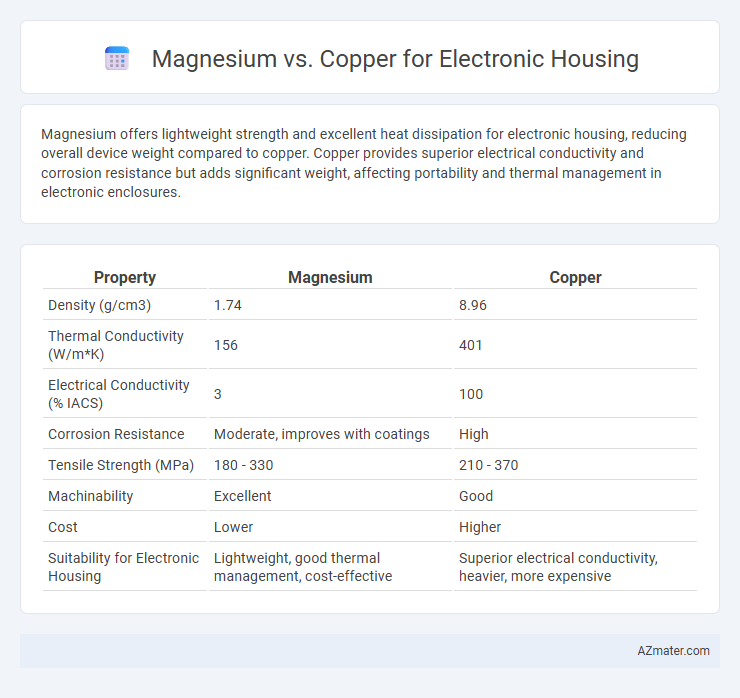Magnesium offers lightweight strength and excellent heat dissipation for electronic housing, reducing overall device weight compared to copper. Copper provides superior electrical conductivity and corrosion resistance but adds significant weight, affecting portability and thermal management in electronic enclosures.
Table of Comparison
| Property | Magnesium | Copper |
|---|---|---|
| Density (g/cm3) | 1.74 | 8.96 |
| Thermal Conductivity (W/m*K) | 156 | 401 |
| Electrical Conductivity (% IACS) | 3 | 100 |
| Corrosion Resistance | Moderate, improves with coatings | High |
| Tensile Strength (MPa) | 180 - 330 | 210 - 370 |
| Machinability | Excellent | Good |
| Cost | Lower | Higher |
| Suitability for Electronic Housing | Lightweight, good thermal management, cost-effective | Superior electrical conductivity, heavier, more expensive |
Introduction to Electronic Housing Materials
Magnesium offers lightweight properties and excellent strength-to-weight ratio, making it ideal for electronic housings where weight reduction is critical. Copper provides superior thermal and electrical conductivity, improving heat dissipation in electronic enclosures. Selecting between magnesium and copper depends on balancing mechanical durability with thermal management requirements in electronic housing design.
Overview of Magnesium and Copper
Magnesium offers a lightweight, high-strength solution for electronic housing, featuring excellent thermal conductivity and corrosion resistance ideal for managing device heat. Copper provides superior electrical and thermal conductivity, ensuring efficient heat dissipation and electromagnetic interference (EMI) shielding in electronic enclosures. Both materials present unique advantages: magnesium excels in weight-sensitive applications, while copper is preferred where maximum thermal and electrical performance is critical.
Physical Properties Comparison
Magnesium offers a density of about 1.74 g/cm3, making it significantly lighter than copper, which has a density of 8.96 g/cm3, ideal for lightweight electronic housing. Copper's thermal conductivity surpasses magnesium, approximately 400 W/m*K compared to 156 W/m*K, enhancing heat dissipation in electronic enclosures. In terms of mechanical strength, magnesium alloys provide good tensile strength around 200-300 MPa, but copper's higher electrical conductivity and corrosion resistance make it preferable for applications requiring robust physical and conductive properties.
Electrical Conductivity: Magnesium vs Copper
Copper exhibits significantly higher electrical conductivity than magnesium, making it the preferred choice for electronic housing where efficient current flow is critical. Magnesium's conductivity is roughly 16% that of copper, which limits its use in applications demanding optimal electrical performance. Despite magnesium's lightweight advantage, copper's superior conductivity ensures better grounding and electromagnetic interference shielding in electronic enclosures.
Thermal Management Capabilities
Magnesium offers superior thermal conductivity values ranging from 150 to 200 W/mK, enabling effective heat dissipation in electronic housings. Copper, with thermal conductivity around 400 W/mK, provides even higher heat transfer efficiency but is denser and heavier, impacting overall device weight. The choice between magnesium and copper for electronic housings depends on balancing thermal management performance with weight and cost considerations.
Corrosion Resistance and Durability
Magnesium offers lightweight properties but has lower corrosion resistance compared to copper, which exhibits superior durability in harsh environments due to its natural corrosion-resistant oxide layer. Copper's high corrosion resistance ensures longer lifespan and better protection against environmental factors such as moisture and oxidation, making it ideal for electronic housings in demanding conditions. Magnesium requires protective coatings to enhance durability, whereas copper often provides inherent corrosion protection without additional treatments.
Weight and Structural Strength
Magnesium alloys offer a significant weight advantage over copper, making them ideal for electronic housing where lightweight materials reduce overall device mass and enhance portability. Copper, while heavier, provides superior electrical conductivity and corrosion resistance, but lacks the structural strength-to-weight ratio that magnesium alloys deliver. Magnesium's high strength-to-weight ratio ensures durable protection for sensitive electronics without adding excessive weight, crucial for aerospace and portable electronics applications.
Manufacturing and Cost Factors
Magnesium offers lightweight properties and excellent machinability, making it ideal for complex electronic housing designs and reducing overall device weight. Copper, while providing superior thermal and electrical conductivity, is denser and more expensive to machine, increasing manufacturing costs. Cost factors favor magnesium due to lower material prices and faster production cycles, though copper's performance benefits justify its use in high-performance or specialized electronic housings.
Environmental Impact and Sustainability
Magnesium offers a lighter weight and lower energy consumption during production compared to copper, significantly reducing the carbon footprint of electronic housings. Copper, while highly recyclable and durable, involves more intensive mining and processing activities that generate greater environmental pollution and energy use. Selecting magnesium for electronic housing promotes sustainability through reduced emissions and resource conservation, aligning with green manufacturing practices.
Best Applications: Choosing the Right Material
Magnesium is ideal for lightweight electronic housings requiring excellent strength-to-weight ratio and heat dissipation, making it suitable for portable devices and aerospace applications. Copper offers superior electrical conductivity and electromagnetic interference (EMI) shielding, preferred in high-frequency electronics and power components. Selecting between magnesium and copper depends on balancing thermal management, mechanical durability, and EMI shielding needs for the specific electronic application.

Infographic: Magnesium vs Copper for Electronic Housing
 azmater.com
azmater.com